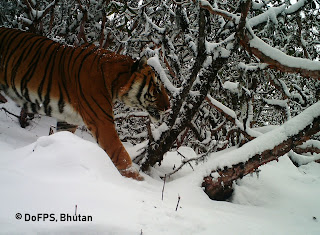Named, Tendrel Zangmo, meaning "auspicious omen"
 |
| Tiger collaring in process: (c) Kuensel |
It was a pleasant surprise from a conservation hero and tiger biologist Dr. Tshering Tempa who is leading the tiger radio-collaring programme in Bhutan, when the news of the first tiger being collared made the headline in National Newspaper on the first day of the first months of Lunar Dog Year, Losar. A wonderful reason to celebrate the New Year and perhaps an "Auspicious Omen" for the future of tiger conservation in Bhutan.
As per the new article, the tiger collared was a 3-year-old female, weighing 110 kgs and the team of foresters and Bhutanese biologists who made this major breakthrough in tiger conservation named her Tedndrel Zangmo, meaning "the auspicious omen".
The tiger (Panthera tigris) is one of the largest carnivores in the world, with its range restricted in but widely spread across Asia, from Turkey in the west to the eastern coast of Russia. There are eight traditionally accepted subspecies of tigers but three subspecies were eradicated as early as the 1980s. Today there is less than 3200 adult tigers in the wild, spread across 7% of their historical range. They remain as one of the most threatened carnivores in the world and the species is listed as Endangered in the IUCN Red List of Threatened Species. Loss of habitat, habitat fragmentation and losing landscape connectivity, prey depletion, and poaching are generally recognized as key threats leading to the decline of tiger population.
 |
| Tiger in Subalpine Mountains of Bhutan |
Panthera tigris tigris, the Bengal Tiger is the subspecies of tiger found in Indian sub-continent and neighboring states including Bhutan. While tiger population elsewhere are facing serious conservation threats, Bhutan's deep-rooted conservation ethos and reverence for tiger as one of the mystical creatures, have provided a safe haven for this animal to thrive. Conservation is further boasted through the visionary policies of our great Monarch with constitution mandating 60% forest cover for all the time to come, and designating over 50% of the country as protected areas and biological corridors. Through this conservation landscape, tigers roam between the country's subtropical jungles at an elevation less than 100 metres above sea level (masl) in Royal Manas National Park in the south to sub-alpine mountains as high as 4400 masl in Northern Wangchuck Centennial National Park. Therefore, Bhutan is the only tiger range country where Tiger and Snow Leopard habitat overlaps. Tiger is strictly protected under Scehdule I of the Forests and Nature Conservation Act of Bhutan 1995, and people guilty of killing tiger are liable for a hefty fine of 1 million Ngultrum (15500.0 USD approx.).
 |
| High-Resolution Image of Wild Tiger in Bhutan |
On the forefront, foresters of Bhutan guard the tigers through intensive antipoaching patrolling using SMART tools and nation embarked to count the tigers using camera trap technology in 2014 and completed the survey successfully in 2015, counted 103 adult tigers with a density of 0.23 tigers per 100 sq.km. This is one of the significant findings in Dr. Tempa's work for this Ph.D. programme, which showed to the world that Bhutan can play a significant role as tiger source sites, in global tiger recovery programme of doubling the tiger number in the world by 2022, from the baseline of 2010. Bhutan otherwise was not included in a popular tiger conservation approach of securing 6% of the total tiger habitat as tiger source sites. While such findings are vital for letting the global community know of Bhutan's tiger conservation efforts, for the Bhutanese conservationist and biologists, it is our solemn duty safeguard our natural heritage with rich biological diversity and pass down to our younger generations, as did by our forefather to us. Successfully collaring Tendrel Zangmo under the leadership of Dr. Thsering Tempa, our own tiger biologists and programme director of Regional Tiger and Cat Research Centre in Bhutan, is but a testimony that we as conservationists can move with the global pace in using modern technologies in conservation, and address the challenging issues.
 |
| Tiger collaring team back in 2015, off to field. |
The radio-collared tiger has a transmitter attached around its neck, which sends the Global Positioning System (GPS) coordinates every hour and the data will be recorded by the receiver by the researcher at the station. The data thus obtained can be very beneficial in understanding the movement pattern of the tiger, the use of migratory corridors, actual home range, etc., which in turn will help in identifying conservation interventions including mitigation of human-wildlife conflict, and preventing g poaching incidents
I had the privilege of being in the core team of Tiger Radio Collaring Project when the maiden radio collar programme began in Royal Manas National Park in November 2015. A team of dedicated foresters, also led by Dr. Tempa tried our best effort to capture one but without success. Perhaps the time was not right then so it is awe-inspiring to learn that it has been a success this time; a great milestone for now and a great opportunity ahead. Congratulations to the Team. For me, it's a wonderful opportunity to have worked with a great tiger biologist of my times at home and have constant guidance and support from him, Thank you Dr. Tshering Tempa.
 |
| Letro: Twitter |
P.S: I made a tweet of the news report and amazed to see my tweet getting the biggest toll of retweets and likes by the enthusiastic conservationists and feline lovers from worldwide. The news seems to have simply awed them.
Link to Dr. Tshering Tempas Ph.D. Dissertation titled "The Ecology of Montane Bengal Tigers (Panthera tigris) in the Himalayan Kingdom of Bhutan".
No comments:
Post a Comment